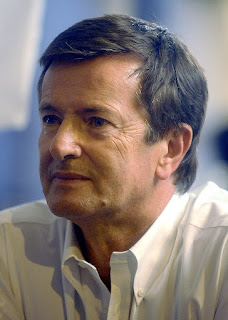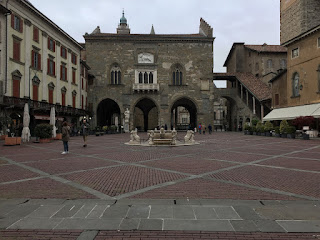Mayor who steered city of Bergamo through Covid nightmare
 |
| Giorgio Gori was elected Mayor of Bergamo for the first time in 2014 |
Of 158,000 deaths from the virus in Italy since it was identified in a patient from the town of Codogno in February 2020, more than 39,000 have been in the Lombardy region, with the city of Bergamo and the surrounding area suffering the heaviest toll.
Bergamo province lost 4,500 citizens in the first month of the pandemic alone and is haunted by the image of a convoy of military vehicles carrying coffins away for cremation elsewhere because the city’s own crematorium could no longer cope with the numbers of dead.
As television crews descended on the city, Gori regularly agreed to be interviewed on camera and thus was seen by audiences in many countries as the story of Covid-19’s devastating impact on Italy dominated news bulletins.
Gori’s own background is in the media. Educated in the magnificent but traditionally demanding surroundings of the Liceo Classico Paolo Sarpi in Bergamo’s historic Città Alta, he went on to study architecture at the University of Milan but at the same time began to contribute to local newspapers, including L’Eco di Bergamo and Bergamo-Oggi, and the city’s own television station, BergamoTV.
In 1984 he began working at Rete4, which at the time belonged to the Arnaldo Mondadori publishing house, but later became part of Silvio Berlusconi’s Mediaset stable, where Gori would work for 15 years. Between 1991 and 2001, he was director of the three Mediaset networks, Rete4, Canale5 and Italia1.
.jpg) |
| Gori is a passionate advocate for the city of Bergamo, where he was born and grew up |
Benedetta and Angelica were both students in England when the pandemic spread across Europe. Their father made headlines by revealing - the day before UK prime minister Boris Johnson announced a national lockdown - that he had flown his daughters home to Italy, despite it being the European epicentre of the pandemic, because he felt the UK response had been too slow.
Gori was guilty of not taking Covid-19 seriously enough at first, infamously posting a picture of himself on social media in early February, 2020, alongside other diners at a Chinese restaurant, with a caption telling people to ignore the "completely unjustified alarmism” and insisting: “There is nothing to fear!"
He subsequently acknowledged his mistake, admitting that he had underestimated the size of the crisis about to unfold, but his political opponents still make capital of the incident.
Gori left Mediaset in 2001 to partner Ilaria Dallatana and Francesca Canetta in setting up a television production company, Magnolia, which specialised in the development and production of original formats for television and interactive media. Magnolia collaborated with the Rai, Mediaset, LA7 and Sky networks and had some memorable successes, including the hit shows L'isola dei famosi, Piazzapulita, MasterChef Italia and L'eredità.
.jpg) |
| Gori's wife, the TV journalist Cristina Parodi, who he met while working for Canale5 |
Even as he pursued a career, he never turned away completely from politics and in 2012 he took the bold decision to leave Magnolia in order to devote himself to fulfilling some political ambitions and to help his home city, for which he had much affection.
He joined the centre-left Democratic Party (PD) and in 2012 worked as a close adviser to Matteo Renzi, then Mayor of Florence, as he prepared what was ultimately his successful bid to become prime minister.
In Bergamo, Gori set up the InNova Bergamo Association with the aim of studying the issues concerning his city and in 2014 was elected the city’s mayor, defeating the incumbent Franco Tentorio, who represented Berlusconi’s centre-right Forza Italia but had previously been a member of two neo-fascist parties, the Italian Social Movement and Allianza Nationale.
Gori failed in his attempt in 2017 to become regional president of Lombardy but in 2019 was re-elected as Mayor or Bergamo, the first to be returned for a second term since the position became subject to a public vote.
During the first Covid-19 lockdown in Italy, Gori wrote a book entitled Riscatto - Bergamo e Italia: Appunti per un futuro possibile (Ransom - Bergamo and Italy: Notes for a possible future) in which he describes his life and professional experiences, the story of Bergamo during the first wave of Covid-19, and sets out his view of the path Italy must take to be reborn after the pandemic.
 |
| The Piazza Vecchia is the focal point of the historic Città Alta, Bergamo's older upper town |
Bergamo in Lombardy is a beautiful city with an upper and lower town that are separated by impressive fortifications. The magical upper town - the Città Alta - has gems of medieval and Renaissance architecture surrounded by the impressive 16th century walls, which were built by the Venetians who ruled at the time. Outside the walls, the elegant Città Bassa, which grew up on the plain below, has some buildings that date back to the 15th century as well as imposing architecture added in the 19th and 20th centuries. While the Città Alta is the draw for many tourists, the lower town also has art galleries, churches and theatres and a wealth of good restaurants and smart shops to enjoy.
 |
| The neoclassical facade of the Liceo Classico Paolo Sarpi in the Città Alta |
The Liceo Classico Paolo Sarpi, the high school attended by Gori, is an historic institution in Piazza Rosate in Bergamo’s Città Alta, opposite the rear entrance of the city’s cathedral. Identifiable by its neoclassical facade designed by Ferdinando Crivelli, the Liceo has its roots in the first public school of Grammar, Humanities, and Rhetorics established by the Republic of Venice in 1506 under the name of Accademia della Misericordia. It was renamed after Paolo Sarpi, a Venetian polymath, in 1803, by Napoleonic decree. The building that houses the modern school was built between 1845 and 1852 under the auspices of the Austrian Government, when it was known as Regio Liceo. In 1860, the academy contributed to the Italian Unification with 70 students joining Garibaldi's Expedition of the Thousand, aimed at annexing the Kingdom of the Two Sicilies to the embryonic Kingdom of Italy. In 2011, the academy took part in the celebration of the 150th anniversary of the Italian unification, attended by the President of the Republic, Giorgio Napolitano. Garibaldi dubbed Bergamo as La Città dei Mille, because of the major role it played in the Expedition of the Thousand.
Also on this day:
1867: The birth of poet and librettist Guido Menasci
1874: The birth of politician and winemaker Luigi Einaudi
1926: The birth of playwright and actor Dario Fo
1934: The birth of photographer Mimmo Jodice
No comments:
Post a Comment